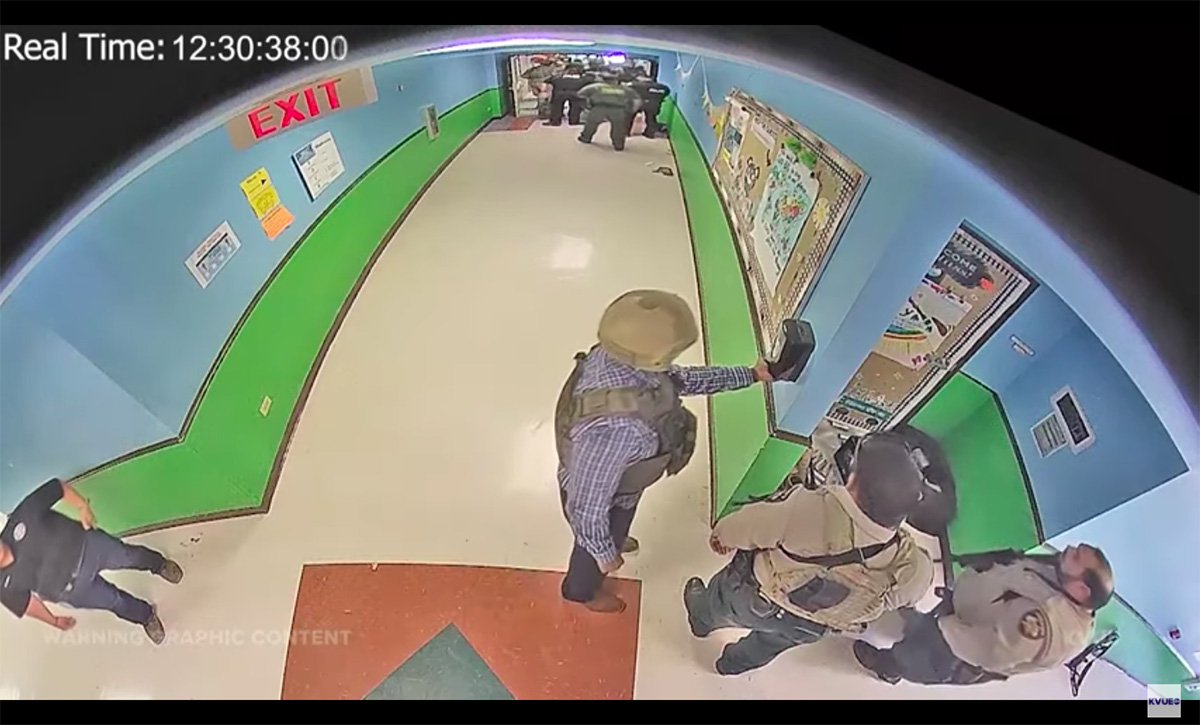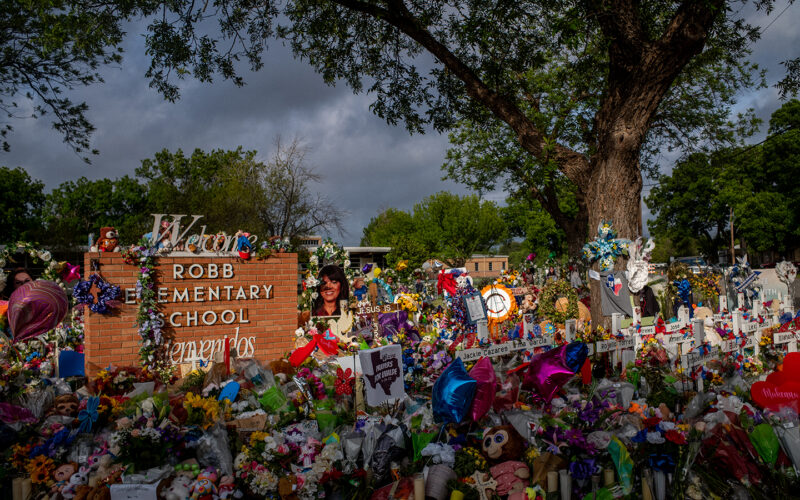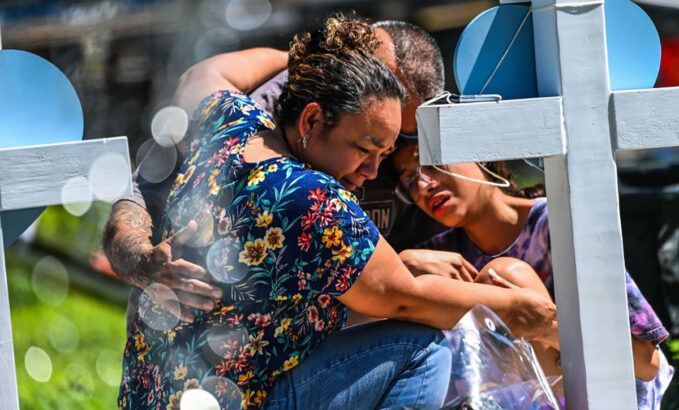Release of Uvalde Shooting Video Sets off Fury, Including Fears of Future Violence
‘The footage is so damning:’ Experts weigh the benefits of holding police accountable against the danger of inciting would-be killers

Get stories like this delivered straight to your inbox. Sign up for The 74 Newsletter
Updated, July 18
A Texas House committee released a 77-page report Sunday on the Uvalde school shooting, concluding that “systemic failures” allowed an 18-year-old gunman to enter Robb Elementary School May 24 and kill 19 children and two teachers. The report, described as the most exhaustive account of the tragedy, cited a disorganized, chaotic law enforcement response crippled by an across-the-board leadership failure, multiple missed warning signs about the shooter’s propensity for deadly violence and a lax atmosphere toward security at the school that had developed over time.
Shortly after Texas news outlets published raw footage of the recent mass school shooting in Uvalde — and of police officers’ gut-wrenching delay in taking out the gunman — shady corners of the internet became a haven for new conspiracy theories.
On 4Chan, the fringe chat board that’s notorious for hosting extremist content, users insisted the 82 minutes of school surveillance camera footage of the May 24 shooting, which resulted in the deaths of 19 children and two teachers, was staged. Rather than depicting one of the deadliest mass school shootings in U.S. history, forum users claimed the heavily armed officers seen milling about were either “crisis actors” or simply participants in a harmless training exercise.
“I didn’t see anyone get shot,” one user commented.
“Saw a lot of police standing around during a live shooter training exercise though,” another said.
The footage jointly released by the Austin American-Statesman newspaper and KVUE TV briefly features the 18-year-old suspect as he walks unimpeded into the school and the piercing sounds of gunfire, but is mostly focused on police standing back in the brightly painted hallway. The news outlets chose to edit out the children’s screams and nobody is shown getting shot on frame, details that quickly became fodder for conspiracy theorists, including one who dubbed it propaganda promoting “DEMOCRAP GUNGRABBING.”
Ever since news outlets released the footage this week inside Robb Elementary School, the small community west of San Antonio has endured a new round of trauma and turbulence. Anger once again focused on the failed police response, as the footage showed how officers with rifles and protective shields idled for more than an hour before confronting the killer, one casually sanitizing his hands from a wall dispenser.
Yet for many, the publication itself became the focus of fury.
While some experts saw the images as critical to holding police accountable, some Texas officials criticized the news outlets for their decision. Uvalde residents, particularly the victims’ families, said releasing the video publicly, before they were scheduled to see it privately first, was re-traumatizing.
“Who in the hell do these people think they are?” Angel Garza, whose daughter Amerie was killed, said on CNN. “You want to go ahead and air their final moments to the entire world. What makes you think that’s OK? The least you can do is have some freaking decency for us.”
Meanwhile, researchers who study school shootings and online extremism warned the footage would likely have intense preoccupation in fringe online communities, including those that advocate real-world violence. The video’s release has opened a debate about whether it serves any utility for the general public and has left some experts concerned that the footage could become useful for someone planning the next fatal attack.
The Uvalde shooting “will have tremendous fascination for a certain segment of the population,” said psychologist Peter Langman, who has spent decades researching the motives and behaviors of school shooters. Time and again, his research has shown, perpetrators study and emulate the behaviors and tactics of previous gunmen.
In a June terror threat bulletin, the Department of Homeland Security warned that online forums dedicated to the glorification of domestic extremist violence have been flooded with posts urging copycat attacks in the wake of Uvalde. Six of the nine deadliest mass shootings in the U.S. since 2018 were carried out by gunmen 21 and younger, and federal law enforcement officials have warned that fringe online forums are being leveraged to radicalize young, violent extremists. Some have seized on the attack “to spread disinformation and incite grievances, including claims it was a government-staged event meant to advance gun control measures,” the threat bulletin warned.
Violent videos are often presented online as memes or jokes and aren’t inherently harmful, said Kurt Braddock, an assistant professor of public communication at American University and a faculty fellow with the Polarization and Extremism Research and Innovation Lab. But such jokes, he said, can serve to radicalize.
“Kids and young people, they have a technological capacity that people who are older never had,” he told The 74. “The problem is that they don’t have the media literacy skills to distinguish what’s a joke and what’s a call to action.”
A compulsive interest with mass shootings in fringe online communities traces back to the 1999 Columbine High School attack in suburban Denver, which has been repeatedly cited by the shooters in subsequent attacks. In online communities, so-called “Columbiners” mull over every detail of the infamous shooting, sharing a vast photo and video archive of the high school gunmen. That includes haunting surveillance video footage from inside the school cafeteria.
“There’s a whole phenomenon of Columbiners, people who are obsessed with every aspect of Columbine and track down every photo they can find of the perpetrators and post them on websites,” said Langman. Because so many people were killed in Uvalde, he said a similar warped pursuit could emerge with the Texas massacre. Intellectual curiosity has driven some people to become obsessed with Columbine and subsequent attacks, Langman said, and others have developed romantic infatuations with the perpetrators. Meanwhile, he said a segment of the community is motivated by the desire for violence.
“Most of the people fascinated with these attacks are not aspiring killers but some of them are likely to be eventual killers and that’s where the potential danger is.”
‘Too graphic’
Surveillance video footage depicting the mayhem inside a school during a shooting is rarely released publicly. Beyond footage of the Columbine cafeteria, a limited selection of videos were made public after the 2018 mass school shooting in Parkland, Florida. But none were as extensive as the footage released in Uvalde, experts said.
The video was published Tuesday by the Texas news outlets nearly a week before state Rep. Dustin Burrows, a Republican leading a legislative investigation into the shooting, had planned to show the video to victims’ families in a private screening before releasing it publicly alongside the probe’s preliminary findings. In a series of tweets on Tuesday, Burrows said he is “glad that a small portion is now available for the public,” which deserves to see police officers’ response to the shooting, but expressed disappointment that victims’ families were unable to see it first. Meanwhile, efforts to withhold certain images and audio of the violence, he said, “were not achieved.”

Uvalde Mayor Don McLaughlin offered a harsher critique, calling the media outlets’ decision to publish the video “one of the most chicken things I’ve ever seen.”
In an op-ed, the Austin newspaper explained that its decision came after “long and thoughtful discussions,” and was done to provide clarity about what happened inside the school after weeks of confusion and repeated misinformation. The newspaper blurred the face of a student who appears momentarily at the beginning of the video and omitted the sounds of children screaming as the gunman entered their fourth grade classroom, a detail they deemed “too graphic.” Editors ultimately chose, however, to show the face of the gunman as he entered the school undeterred.
“Our news organization guidelines state that we should not glorify these individuals and give them the notoriety that they seek,” the paper said in the op-ed. “We chose, in this instance, to show his face to chisel away at any conspiracy that we are hiding something.”
Such conspiracy theories had already become widespread in online forums, including 4Chan. In one online forum dedicated to mass shootings, users compared the Uvalde suspect to the perpetrator who carried out the 2012 attack on Sandy Hook Elementary School in Newtown, Connecticut, commenting on their physical and strategic similarities. The forum, whose previous users have included multiple mass shooters, including the Newtown gunman, was flooded with screenshots of the Uvalde suspect’s social media posts.
Since the Columbine shooting, standard law enforcement procedures have called on officers to respond to threats immediately even at risk of their own lives, said campus security consultant Kenneth Trump, president of the Cleveland-based National School Safety and Security services. The hallway video from Uvalde, he said, is critical to hold police accountable for their hour-long delay before confronting the gunman. There’d be reason to withhold footage that depicts the gunman killing children, he wrote in an email, but not of officers in the hallway. That footage, he said, made clear that police lacked a coordinated response during the mayhem.
“That is fair game for public scrutiny especially given the conflicting accounts and finger pointing by public officials,” Trump said. “There are questions about accountability and you cannot have accountability without transparency.”
Sen. Chris Murphy, a Democrat from Connecticut and a leading proponent of tighter gun control measures, also sees utility in the video. In an appearance Wednesday on MSNBC, Murphy said it clearly dispels a common right-wing talking point that “the only way to stop a bad guy with a gun is good guys with a gun.”
“If one teenager with a high-powered weapon is so scary as to prevent all of those highly trained adults from going in and saving lives, maybe we should try to stop those teenagers from having those kinds of guns in the first place,” Murphy said. “Because clearly, we never have enough good guys with guns. We can never have enough high-powered weapons in the hands of law enforcement to stop an assailant if we couldn’t get that job done given what we have seen on the tapes in Uvalde.”
Yet for all its persuasive power, Murphy noted the traumatizing nature of the footage, saying “I don’t recommend that people watch it.”
A right to know?
For years to come, the hallway video will serve as a mass-shooting training tool for police, said Jaclyn Schildkraut, an associate criminal justice professor at the State University of New York at Oswego. And given the intense scrutiny of the officers’ response, she said “the only way to set the record straight is to release this video.”
“The footage is so damning,” she said. “You had officers sitting there on their phones, you had an officer who was not only on his phone but then went and sanitized his hands. It’s incredibly problematic.”

Several officers can be seen checking their phones during the long standoff in the hallway, although a Texas lawmaker clarified that one who had come under particular attack was Uvalde school police Officer Ruben Ruiz, whose wife, Eva Mireles, had called her husband to tell him she had been shot inside the classroom. Mireles and her co-teacher, Irma Garcia, were both killed protecting their students.
Schildkraut said the video has limited value in the public domain, and could actually be harmful for the families of the victims who will be forced to relive the tragedy for the rest of their lives. They should have been given a say about the video’s public release, she argued, while noting the footage could fall into the wrong hands.
“There’s going to be people who come up with conspiracy theories and then go harass the families because that’s what they did in Sandy Hook and they’ve done elsewhere,” she said. “This could end up on the dark web and people could idolize this individual even more. What public value does it add?”
After the Sandy Hook shooting, conspiracy theorists flooded the internet with claims the tragedy was a “false flag.” Last year, conspiracy theorist and InfoWars host Alex Jones was held liable for damages in a defamation lawsuit by victims’ families for his repeated claims that the shooting was a hoax.
A similar debate over the public’s right to know key details also followed the Columbine shooting, Langman said. Extensive footage has become publicly available, including the cafeteria surveillance video and other homemade videos created by the perpetrators. But some were never publicized, most notably the “basement tapes,” which reportedly included some four hours of film that offer a window into the motives and plans of the perpetrators just weeks before they carried out the attack. The tapes were reportedly destroyed due to concerns they could inspire more violence.
American University’s Braddock said the Uvalde hallway video presents a catch-22. Transparency around the police response is important, he said, but it also offers a wealth of material to online circles of people with morbid curiosities or worse
“It’s so easy to turn the images from that video into memes that can circulate within these circles online, and those can serve to build other little communities of would-be mass shooters,” he said.
Get stories like these delivered straight to your inbox. Sign up for The 74 Newsletter

;)
